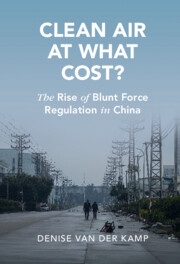Book contents
- Clean Air at What Cost?
- Cambridge Studies in Law and Society
- Clean Air at What Cost?
- Copyright page
- Dedication
- Contents
- Figures
- Tables
- Acknowledgments
- Abbreviations
- Chapter 1 Introduction
- Chapter 2 Blunt Force Regulation
- Chapter 3 Why Blunt Force Regulation?
- Chapter 4 Blunt Force Regulation and Bureaucratic Control
- Chapter 5 The Impact of Blunt Force Regulation
- Chapter 6 What Are the Alternatives?
- Chapter 7 Managing the Risks
- Chapter 8 Comparative Implications
- Chapter 9 Conclusion
- Appendix
- Bibliography
- Index
- Cambridge Studies in Law and Society
Chapter 6 - What Are the Alternatives?
Published online by Cambridge University Press: 28 January 2023
- Clean Air at What Cost?
- Cambridge Studies in Law and Society
- Clean Air at What Cost?
- Copyright page
- Dedication
- Contents
- Figures
- Tables
- Acknowledgments
- Abbreviations
- Chapter 1 Introduction
- Chapter 2 Blunt Force Regulation
- Chapter 3 Why Blunt Force Regulation?
- Chapter 4 Blunt Force Regulation and Bureaucratic Control
- Chapter 5 The Impact of Blunt Force Regulation
- Chapter 6 What Are the Alternatives?
- Chapter 7 Managing the Risks
- Chapter 8 Comparative Implications
- Chapter 9 Conclusion
- Appendix
- Bibliography
- Index
- Cambridge Studies in Law and Society
Summary
This chapter argues that the Chinese leadership is trying to transition out of blunt force regulation by increasing investments in 1) conventional regulatory institutions, which offer more efficient, sustainable pollution control, and 2) bottom-up enforcement, where citizens are used as “fire alarms” to strengthen the threat of conventional enforcement institutions.Using a case study of antipollution protests in a wealthy Chinese city – a case that, at the outset, appeared likely to succeed at improving government enforcement – this chapter examines how the state’s ambivalence to civil society activism closes off channels for effective bottom-up enforcement. Further interview evidence reveals that as an authoritarian state, Chinese officials fear the accountability mechanisms (such as a free press, independent judiciary, and community activism) that make bottom-up enforcement so effective in other countries. These limitations have pushed the leadership to repeatedly return to blunt force solutions, suggesting that it is not just a transition phase.
Keywords
- Type
- Chapter
- Information
- Clean Air at What Cost?The Rise of Blunt Force Regulation in China, pp. 106 - 130Publisher: Cambridge University PressPrint publication year: 2023



